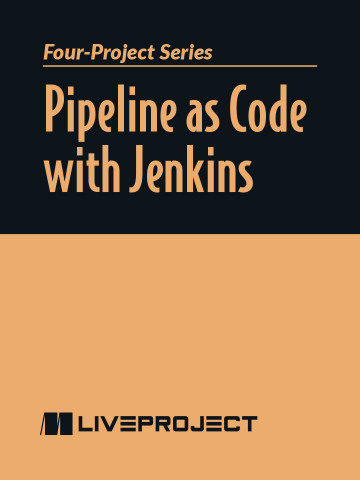Pipeline as Code with Jenkins you own this product
- prerequisites
- basics of Jenkins • basics of CI/CD
- skills learned
- Jenkins setup and configuration • using Jenkinsfile • creating a declarative pipeline script with Blue Ocean • multi-branch pipelines
pro $24.99 per month
- access to all Manning books, MEAPs, liveVideos, liveProjects, and audiobooks!
- choose one free eBook per month to keep
- exclusive 50% discount on all purchases
lite $19.99 per month
- access to all Manning books, including MEAPs!
team
5, 10 or 20 seats+ for your team - learn more

In this series of liveProjects, you’ll use pipeline-as-code techniques and Jenkins infrastructure to set up new CI/CD pipelines for software development. Stepping into the role of an automation engineer looking for a better way to manage application lifecycle activities, you’ll implement DevOps practices such as continuous integration and continuous delivery using Jenkins Pipeline (pipeline-as-code). To do this, you’ll use a declarative pipeline and Blue Ocean to create a Jenkinsfile for pipeline-as-code adoption. CI/CD pipelines that are iterated as pipeline-as-code are some of the most robust and easy-to-use features of Jenkins for non-technical colleagues.
For more on CI/CD implementation using Pipeline as Code, please see CI/CD Pipeline for a Web Application Using Jenkins.
For any beginners these projects will be a good start with Jenkins pipeline.
here's what's included

In this liveProject, you’ll overhaul the CI/CD pipeline of a news and entertainment company to make it fit-for-purpose for an Agile cultural transformation. In order to create a pipeline that can manage quality, execute tests, calculate code coverage, and efficiently deploy applications or microservices, you’ve decided to implement pipeline-as-code. You’ll use Jenkins for the setup, then automate tasks and ensure they’re reliable, efficient, and repeatable. Your challenges include installing Jenkins, executing your pipeline to automation requirements, distributing architecture to manage the load on Jenkins, and quickly executing modifications to your pipeline.

In this liveProject, you’ll use Jenkinsfile to store pipeline script in a version control system. You’ll first create a declarative pipeline using Jenkinsfile, then generate a pipeline script using pipeline syntax. These challenges will help build your understanding of the basics of pipeline creation in declarative syntax.

In this liveProject, you’ll create a CI/CD pipeline using pipeline-as-code and Blue Ocean. Blue Ocean is a new user interface that allows beginners and non-technical users to graphically create, visualize, and diagnose CI/CD pipelines. Your company needs all employees to be able to work with this pipeline irrespective of their technical backgrounds, so you’ll ensure that this pipeline is easy to replicate without scripting experience. You’ll ensure that specific steps can be executed after a pipeline or stage is complete.

In this liveProject, you’ll create and configure a multi-branch pipeline, then group it in one pipeline-as-code project with Jenkins so all the pipelines for a repository are managed together. Working for a mature company with a well-established but branching CI/CD pipeline, you’ll manage pipelines in different branches available in the repository. The multi-branch pipeline helps maintain pipelines easily when there are many repositories and each has different branches that need to be managed.

choose your plan
team
- five seats for your team
- access to all Manning books, MEAPs, liveVideos, liveProjects, and audiobooks!
- choose another free product every time you renew
- choose twelve free products per year
- exclusive 50% discount on all purchases
-
![]() Pipeline as Code with Jenkins project for free
Pipeline as Code with Jenkins project for free
Prerequisites
This liveProject is for beginner to intermediate automation engineers. To begin this liveProject you will need to be familiar with the following:
TOOLS
- Basics of Jenkins
- Basics of AWS
- Basics of Linux
- Basics of CI/CD
- Basics of distributed architecture
Note: These projects use Amazon EC2 instances, which require a paid AWS account.
 features
features
- Self-paced
- You choose the schedule and decide how much time to invest as you build your project.
- Project roadmap
- Each project is divided into several achievable steps.
- Get Help
- While within the liveProject platform, get help from fellow participants and even more help with paid sessions with our expert mentors.
- Compare with others
- For each step, compare your deliverable to the solutions by the author and other participants.
- book resources
- Get full access to select books for 90 days. Permanent access to excerpts from Manning products are also included, as well as references to other resources.



 Pipeline as Code with Jenkins project for free
Pipeline as Code with Jenkins project for free